Search
- Page Path
-
- HOME
- Search
- Correspondence and Reply
- Neurobehavior
- Association between polycystic ovary syndrome and risk of attention-deficit/hyperactivity disorder in offspring: a meta-analysis
- Ensiyeh Jenabi
- Clin Exp Pediatr. 2022;65(3):152-152. Published online February 17, 2022
-
- Editorial
- Infection
- Importance of maintaining a high childhood vaccination rate and surveillance program against Japanese encephalitis in Korea
- Su Eun Park
- Clin Exp Pediatr. 2022;65(3):127-128. Published online February 16, 2022
-
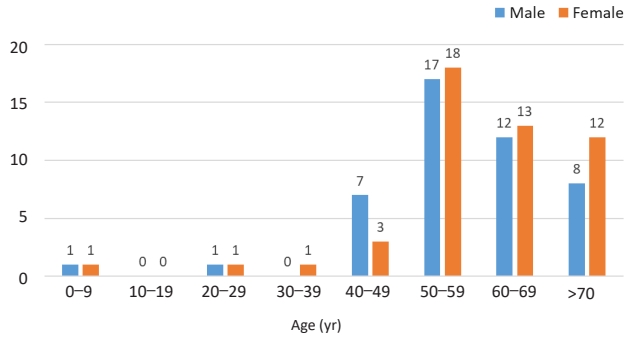
∙ Recent epidemiologic changes of Japanese encephalitis (JE) in Korea are area (rural to urban or suburban) and age shift (children to adult).
∙ Although the main factors contributing to recent epidemiologic changes of JE are not well identified, maintaining high vaccination rates of JE appear to be important in preventing of JE in all age groups.
∙ Continuous surveillance for epidemiology and seroprevalence should be carried out.
- Review Article
- Neurology
- Rotavirus infection-associated central nervous system complications: clinicoradiological features and potential mechanisms
- Kyung Yeon Lee
- Clin Exp Pediatr. 2022;65(10):483-493. Published online February 7, 2022
-

∙ Rotavirus infection-associated central nervous system (CNS) complications are fairly common in children.
∙ Common clinicoradiological features include benign convulsions with mild gastroenteritis, acute encephalopathies/encephalitis, cerebellitis, and neonatal rotavirus-associated leukoencephalopathy.
∙ Possible mechanisms for CNS complications include direct viral invasion into the brain via several potential routes such as the blood-brain barrier and vagus nerve, and entry of various brain-damaging mediators and activated immune cells into the brain.
- Letter to the Editor
- Neonatology (Perinatology)
- Telemedicine as progressive treatment approach for neonatal jaundice due to the coronavirus disease 2019 pandemic
- Sukanya Sudhir Joshi, Bithiah Roy Benroy, Isabell Nelson Lawrence, Thanuja Jayasri Suresh
- Clin Exp Pediatr. 2022;65(5):269-271. Published online February 7, 2022
-
Question: How can the management of neonatal jaundice (NJ) be enhanced through telemedicine?
Finding: Teleconsultations, drive-through testing, and the use of an application to assess neonatal jaundice at home are being successfully used, but they must be further researched before being implemented on a larger scale.
Meaning: Recent technology allows for the treatment of NJ at home with an application that helps reduce hospital burden.
- Editorial
- Allergy
- Dietary restriction misconceptions and food allergy education in children with atopic dermatitis
- You Hoon Jeon
- Clin Exp Pediatr. 2022;65(2):83-84. Published online January 27, 2022
-
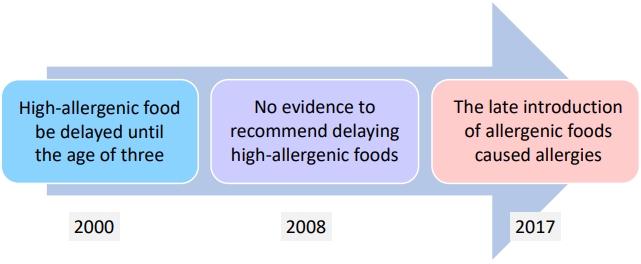
∙ Food intake strategies for preventing food allergies have undergone major changes over the past 20 years.
∙ In children with atopic dermatitis, indiscriminate food restrictions without diagnostic testing leads to nutritional imbalance and poor growth.
∙ When determining food restrictions for pediatric patients with atopic dermatitis, an accurate food allergy diagnosis must be preceded, and continuous parental education about food intake is required.
- Endocrinology
- Clinical and diagnostic importance of dyslipidemia in children and adolescents during the coronavirus disease 2019 pandemic
- Eun Young Kim
- Clin Exp Pediatr. 2022;65(3):129-130. Published online January 14, 2022
-
∙ Because childhood lipid concentrations continue into adulthood, early evaluation and treatment are needed, but dyslipidemia awareness is low.
∙ For the prevention and treatment of dyslipidemia in childhood and adolescence, a major risk factor for cardiovascular disease in adulthood, lifestyle modifications, appropriate exercise, and drug treatment are required.
∙ A large-scale study of the prevalence and therapeutic effects of dyslipidemia in children and adolescents in Korea is needed.
- Neurology
- Cerebrospinal fluid biomarkers in various pediatric neurologic diseases
- Jeongho Lee
- Clin Exp Pediatr. 2022;65(2):81-82. Published online January 6, 2022
-

Cerebrospinal fluid (CSF) has many important biomarkers that are commonly analyzed in pediatric neurologic diseases, including central nervous system infection and inflammation. Neurologic disease in pediatrics is difficult to diagnosis, there are challenges in developing CSF profiles. Some biomarkers are expected to help differential diagnosis.
- Endocrinology
- Pediatric obesity: life cycle approach of pediatrician and society
- Yong Hee Hong
- Clin Exp Pediatr. 2022;65(1):29-30. Published online December 28, 2021
-
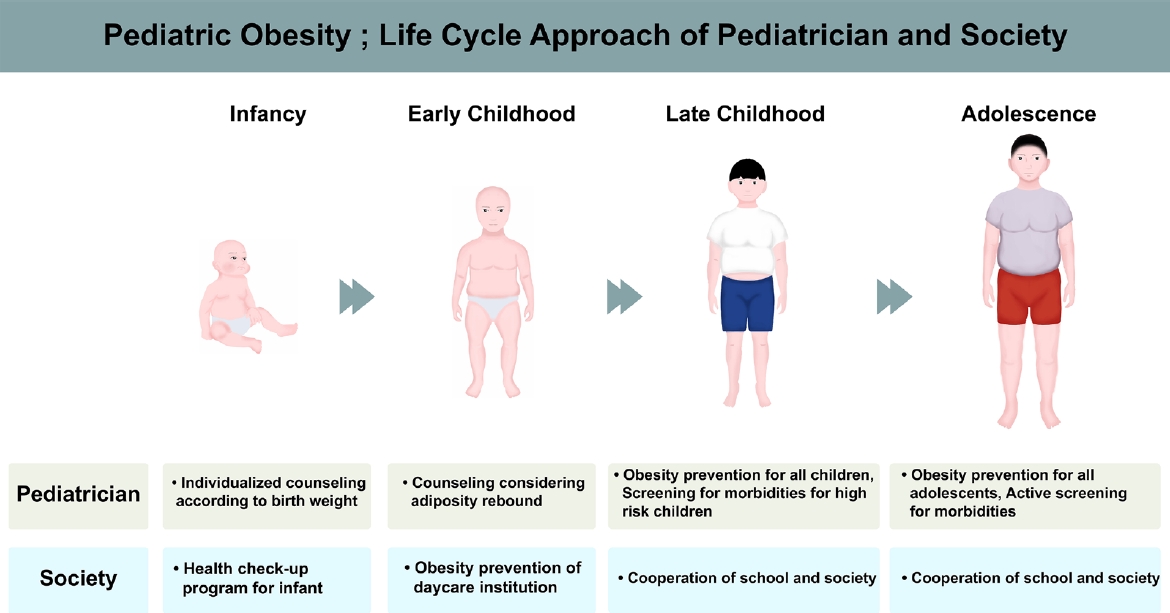
• With the emerging epidemic of pediatric obesity, many endocrine comorbidities classically seen in adulthood are surfacing much earlier in life.
• Appropriate obesity counseling and education should be provided from infancy to adolescence.
• Managing pediatric obesity may require school and society involvement.
- Review Article
- Neurology
- Update on benign convulsions with mild gastroenteritis
- Yeong Seok Lee, Ga Hee Lee, Young Se Kwon
- Clin Exp Pediatr. 2022;65(10):469-475. Published online December 27, 2021
-

∙ The main pathogen for benign convulsions with mild gastroenteritis (CwG) was previously rotavirus; however, cases associated with norovirus are increasing.
∙ CwG is characterized by clustered generalized seizures. Electroencephalography and magnetic resonance imaging show transiently abnormal findings in the acute phase that eventually normalize with progression. Its prognosis is good, and long-term treatment is unnecessary.
∙ There are many reports on the pathophysiological mechanism of CwG, which remains unclear.
- Oncology
- Application of 3-dimensional printing implants for bone tumors
- Jong Woong Park, Hyun Guy Kang
- Clin Exp Pediatr. 2022;65(10):476-482. Published online December 23, 2021
-

∙ The application of 3-dimensional (3D) printing in orthopedic oncology is summarized into bone and tumor modeling, patient-specific instruments (PSIs), custom-made implants, and tissue engineering.
∙ The 3D-printed customized implant is the most central application, while modeling and PSI often play adjunct roles.
∙ Short-term surgical outcomes of custom-made 3D-printed implants are promising.
- Gastroenterology
- Factors influencing development of the infant microbiota: from prenatal period to early infancy
- Sujin Jeong
- Clin Exp Pediatr. 2022;65(9):439-447. Published online December 23, 2021
-
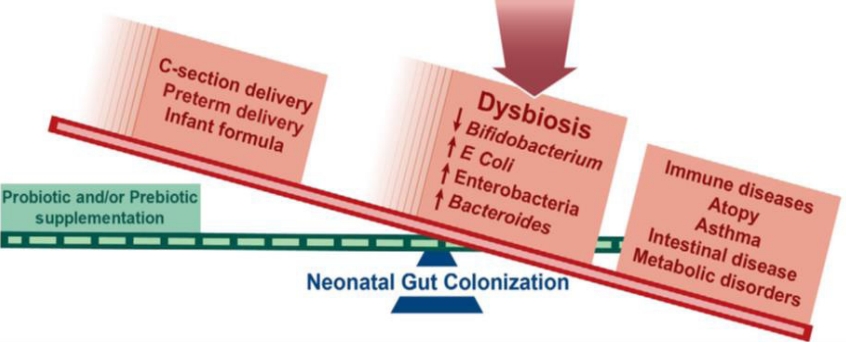
∙ Microbial colonization primarily occurs after birth but there may be some colonization in utero, although this remains highly controversial.
∙ Maternal factors during pregnancy affect the infant microbiota: diet, weight, gestational weight gain, and antibiotic usage.
∙ Microbes are passed from mother-to-infant during and after birth. Delivery mode, breastfeeding, early life antibiotic, and proton pump inhibitor treatment have the largest effects on microbial composition in early life.
∙ The early life gut microbiome plays an important role in the development of the immune system and metabolism.
- Cardiology
- Diagnosis of coronary artery abnormalities in Kawasaki disease: recent guidelines and z score systems
- Sung Hye Kim
- Clin Exp Pediatr. 2022;65(9):430-438. Published online December 17, 2021
-
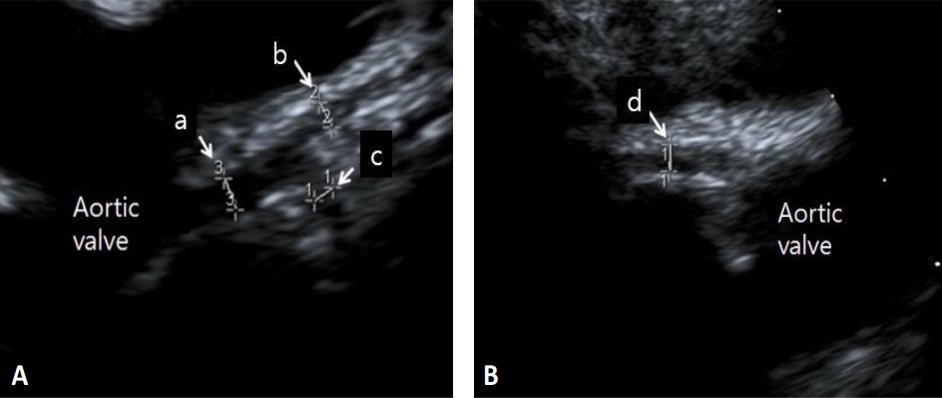
∙ Kawasaki disease is the leading cause of acquired heart disease among children in the developed countries, and Korea has the second-highest incidence in the world.
∙ Early diagnosis and proper treatment are imperative to prevent coronary complication, and evaluation of coronary artery abnormalities is fundamental.
∙ Recent guidelines have adapted z score system for the diagnosis of coronary artery abnormalities in Kawasaki disease.
∙ Applying z score in diagnosis of coronary abnormalities has better correlation with clinical outcomes than absolute cutoff values.
∙ Calculated z scores could be different according to the z score formula, which might influence the treatment plan.
- Neurology
- Recent trends of healthcare information and communication technologies in pediatrics: a systematic review
- Se young Jung, Keehyuck Lee, Hee Hwang
- Clin Exp Pediatr. 2022;65(6):291-299. Published online December 15, 2021
-
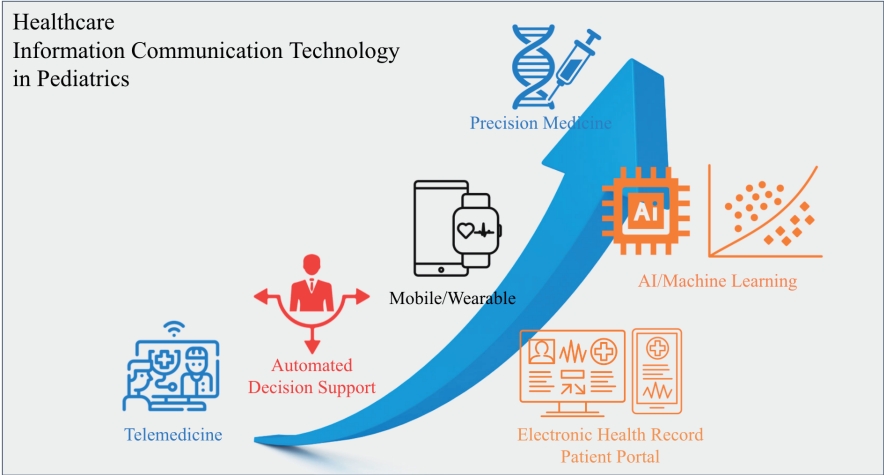
· The innovation of healthcare information communication technology (ICT) was accelerated with the adoption of electronic health records (EHRs).
· Telemedicine currently has no technical barriers.
· EHRs and personal health records are being connected, and mobile/wearable technologies are being integrated into them.
· Conventional rule-based clinical decision support systems have already been implemented and used in EHRs and PHRs. Artificial intelligence/machine learning improves precision and accuracy.
- Neonatology (Perinatology)
- Breastfeeding and vitamin D
- Ju Sun Heo, Young Min Ahn, Ai-Rhan Ellen Kim, Son Moon Shin; for the Korean Society of Breastfeeding Medicine
- Clin Exp Pediatr. 2022;65(9):418-429. Published online December 14, 2021
-
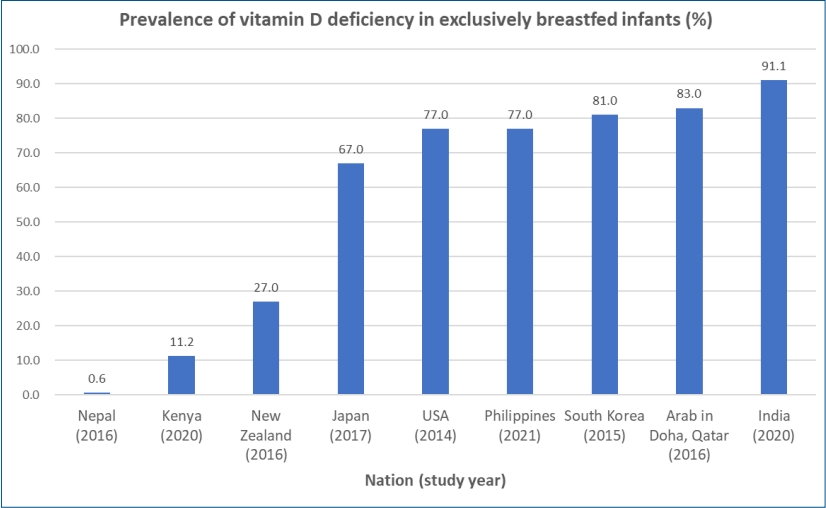
∙ Exclusively breastfed infants are at risk of developing vitamin D deficiency associated with hypocalcemia, rickets, and various health outcomes.
∙ The prevalence of vitamin D deficiency in breastfed infants differs vastly between studies and nations at 0.6%–91.1%.
∙ The vitamin D content of breast milk does not meet the requirements of exclusively breastfed infants.
∙ Most international guidelines recommend that breastfed infants be supplemented with 400 IU/day of vitamin D during the first year of life.
∙ Vitamin D intake (milk+supplements) of 800 IU/day can be considered in preterm infants along with biochemical monitoring.
- Original Article
- Neonatology (Perinatology)
- Neonatal sepsis-causing bacterial pathogens and outcome of trends of their antimicrobial susceptibility a 20-year period at a neonatal intensive care unit
- Woo Sun Song, Hye Won Park, Moon Youn Oh, Jae Young Jo, Chae Young Kim, Jung Ju Lee, Euiseok Jung, Byong Sop Lee, Ki-Soo Kim, Ellen Ai-Rhan Kim
- Clin Exp Pediatr. 2022;65(7):350-357. Published online December 9, 2021
-

Question: What is prevalence of bacterial pathogens causing sepsis and their antimicrobial susceptibility over 20 years?
Finding: Coagulase-negative remains most common causative organism. The most common gram-negative organism was Klebsiella pneumonia. The susceptibility of staphylococcus aureus and K. pneumonia showed increased susceptability to oxacillin, cefotaxime and amikacin, gentamicin, respectively.
Meaning: Answers to the question asked is important in choosing antimicrobials and to monitor emergence of multidrug-resistant organisms.
- Neurology
- Neurodevelopmental outcomes and comorbidities of children with congenital muscular torticollis: evaluation using the National Health Screening Program for Infants and Children database
- Og Hyang Kim, Seung Won Lee, Eun Kyo Ha, Ju Hee Kim, Yun Hye Jo, Seongyeong Rhie, Man Yong Han, Kyu Young Chae
- Clin Exp Pediatr. 2022;65(6):312-319. Published online December 9, 2021
-
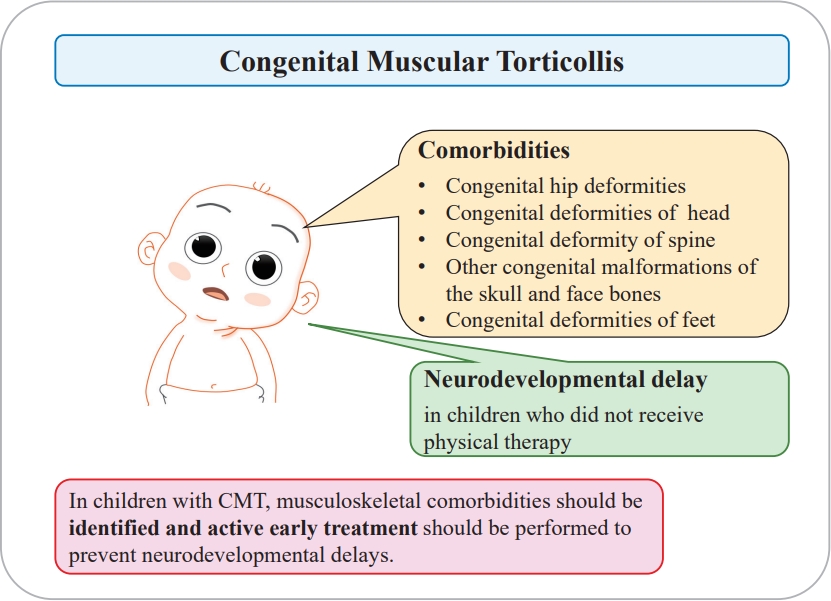
Question: What comorbidities are increased in children with congenital muscular torticollis (CMT)? Are there differences in the neurodevelopmental outcomes of children with CMT who received physical therapy versus those who did not?
Finding: The risk of congenital musculoskeletal deformities is increased in CMT. Children who did not receive physical therapy were at greater risk of neurodevelopmental delay.
Meaning: In CMT, musculoskeletal comorbidities should be identified and active early treatment provided.
- Review Article
- General Pediatrics
- A new perspective on cholesterol in pediatric health: association of vitamin D metabolism, respiratory diseases, and mental health problems
- Jeana Hong
- Clin Exp Pediatr. 2022;65(2):65-72. Published online December 9, 2021
-
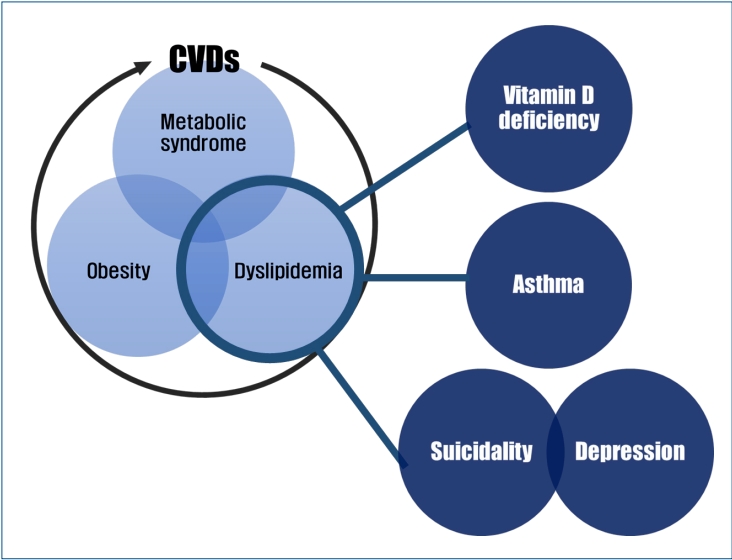
∙ Pediatric dyslipidemia is associated with several health problems besides cardiovascular diseases.
∙ There is a direct association between pediatric dyslipidemia and low serum vitamin D levels, asthma, and mental health problems regardless of body mass index.
∙ More large-scale nationally representative studies are needed to establish the appropriate cutoff points for the definition of dyslipidemia that is a prerequisite for further epidemiological studies in the Korean pediatric population.
- Original Article
- Cardiology
- Early myocardial functional abnormalities in primary dyslipidemia: clinical and echocardiographic observations in young children from a highly consanguineous population
- Nehal M. El-koofy, Aya M. Fattouh, Areef Ramadan, Mohamed A. Elmonem, Dina H. Hamed
- Clin Exp Pediatr. 2022;65(8):410-416. Published online December 8, 2021
-
In children with primary dyslipidemia, functional myocardial abnormalities can occur at young age, including diastolic functional impairment of both ventricles and narrowing of the aortic valve and the sinus of Valsalva. Echocardiographic evaluations of high-risk children may be as important as biochemical evaluations.
- Clinical note
- General Pediatrics
- Diabetic ketoacidosis in children induced by coronavirus disease 2019 (COVID-19) diabetic ketoacidosis post-COVID-19 in children
- Neha Thakur, Narendra Rai
- Clin Exp Pediatr. 2022;65(4):209-210. Published online November 30, 2021
-
- Review Article
- Infection
- Epidemiological changes in infectious diseases during the coronavirus disease 2019 pandemic in Korea: a systematic review
- Jong Gyun Ahn
- Clin Exp Pediatr. 2022;65(4):167-171. Published online November 30, 2021
-
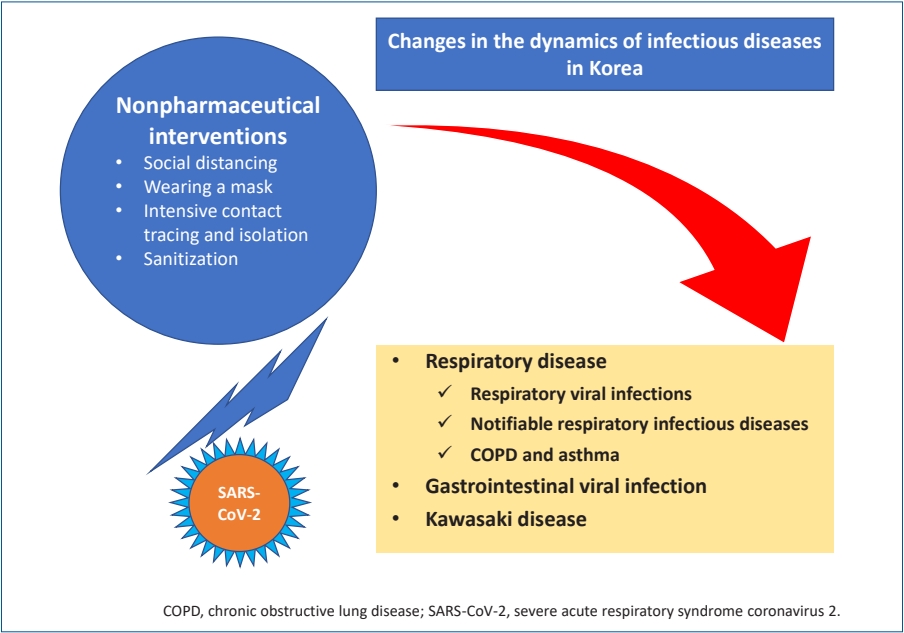
· Nonpharmaceutical interventions (NPIs) have had a major impact on the epidemiology of various infectious diseases in Korea.
· Respiratory diseases and gastrointestinal viral diseases were significantly reduced during the NPI period.
· The decrease in Kawasaki disease after the introduction of NPI is an unintended result.
· Infectious diseases that decreased during NPI use may re-emerge.
· We must continuously monitor the epidemiology of various infectious diseases during the coronavirus era
- Endocrinology
- Pediatric hypertension based on Japanese Society of Hypertension Guidelines (JSH 2019) with actual school blood pressure screening data in Japan
- Toru Kikuchi
- Clin Exp Pediatr. 2022;65(6):283-290. Published online November 26, 2021
-

The prevalence of Japanese pediatric hypertension is 0.9% based on proper measurement protocols. Hypertensive children tend to be hypertensive adults. Pediatric essential hypertension is characterized by an absence of symptoms, obesity, a family history of hypertension, and a low birth weight. The most common causes of pediatric secondary hypertension are renal parenchymal and renovascular diseases. Important factors controlling pediatric hypertension include healthy lifestyle modifications and pharmacotherapy.
- Neurology
- Big data analysis and artificial intelligence in epilepsy – common data model analysis and machine learning-based seizure detection and forecasting
- Yoon Gi Chung, Yonghoon Jeon, Sooyoung Yoo, Hunmin Kim, Hee Hwang
- Clin Exp Pediatr. 2022;65(6):272-282. Published online November 26, 2021
-

· Big data analysis, such as common data model and artificial intelligence, can solve relevant questions and improve clinical care.
· Recent deep learning studies achieved 0.887–0.996 areas under the receiver operating characteristic curve for automated interictal epileptiform discharge detection.
· Recent deep learning studies achieved 62.3%–99.0% accuracy for interictal-ictal classification in seizure detection and 75.0%– 87.8% sensitivity with a 0.06–0.21/hr false positive rate in seizure forecasting.
- Other
- Knowledge-guided artificial intelligence technologies for decoding complex multiomics interactions in cells
- Dohoon Lee, Sun Kim
- Clin Exp Pediatr. 2022;65(5):239-249. Published online November 26, 2021
-

· The need for data-driven modeling of multiomics interactions was recently highlighted.
· Many artificial intelligence-driven models have been developed, but only a few have incorporated biological domain knowledge within model architectures or training procedures.
· Here we provide a comprehensive review of deep learning models to decipher complex multiomics interactions regarding the biological guidance imposed upon them to facilitate further development of biological knowledge-guided deep learning models.
- Letter to the Editor
- Oncology
- Retrospective review of severe acute respiratory syndrome coronavirus-2 infection in children with acute leukemia from a tertiary care hospital in Northern India
- Suhail Chhabra, Aditya Dabas, Richa Mittal, Neha Goel, Ritabrata Roy Chowdhary, Satyendra Batra, Amitabh Singh, Rani Gera
- Clin Exp Pediatr. 2022;65(3):150-151. Published online November 26, 2021
-
- Review Article
- Infection
- Etiological and pathophysiological enigmas of severe coronavirus disease 2019, multisystem inflammatory syndrome in children, and Kawasaki disease
- Jung-Woo Rhim, Jin-Han Kang, Kyung-Yil Lee
- Clin Exp Pediatr. 2022;65(4):153-166. Published online November 23, 2021
-
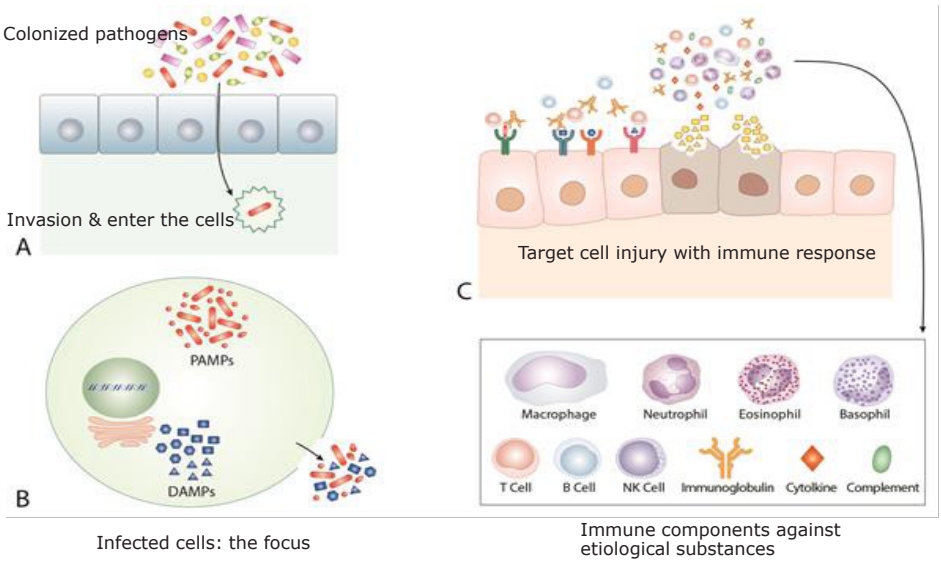
· Severe cases of coronavirus disease, Kawasaki disease (KD), and multisystem inflammatory syndrome in children (MIS-C) share similar findings: a protracted clinical course, multiorgan involvement, and similar activated biomarkers.
· Here we propose etiological agents in KD and MIS-C as species in the microbiota and introduce a common pathogenesis through the protein-homeostasis-system hypothesis.
· Early proper dose of corticosteroids and/or intravenous immunoglobulin may help to reduce morbidity and mortality in these diseases.
- Original Article
- Developmental and Behavioral Medicine
- Effectiveness of obesity interventions among South Korean children and adolescents and importance of the type of intervention component: a meta-analysis
- Siyoung Choe, Jaesin Sa, Jean-Philippe Chaput, Deokjin Kim
- Clin Exp Pediatr. 2022;65(2):98-107. Published online November 23, 2021
-

Question: What is the overall effect of obesity interventions among Korean children and what affects their effectiveness?
Finding: Interventions were strongly favored over controls. Interventions including at least one physical activity component were significantly better than those that did not. Sex, age, baseline weight category, intervention duration, and the number of intervention components were not significant.
Meaning: Future obesity interventions for Korean children must seek to include physical activity components.
- General Pediatrics
- Effect of 2–6 weeks of systemic steroids on bone mineral density in children
- Athira Kuniyil, Somdipa Pal, Namrita Sachdev, Tribhuvan Pal Yadav
- Clin Exp Pediatr. 2022;65(5):254-261. Published online November 18, 2021
-

Question: Does steroid use for 2–6 weeks in children affect bone mineral content (BMC) or density (BMD)?
Finding: Steroid use for 2–6 weeks significantly decreased BMC and BMD of the whole body, total body less the head, lumbar spine, and distal radius. A significant negative correlation was observed among BMD, duration, and cumulative dose.
Meaning: Steroid use for 2–6 weeks in children negatively affected BMC and BMD.
- Endocrinology
- Effects of probiotics combined with dietary and lifestyle modification on clinical, biochemical, and radiological parameters in obese children with nonalcoholic fatty liver disease/nonalcoholic steatohepatitis: a randomized clinical trial
- Thushara Rodrigo, Samaranayake Dulani, Sumudu Nimali Seneviratne, Arjuna P. De Silva, Jerad Fernando, H. Janaka De Silva, Jayasekera , V. Pujitha Wickramasinghe
- Clin Exp Pediatr. 2022;65(6):304-311. Published online November 11, 2021
-

Question: Could probiotics be used as a therapeutic modality in nonalcoholic fatty liver disease/nonalcoholic steatohepatitis?
Finding: There seem no added advantages over lifestyle modifications compared to Probiotics.
Meaning: There does not seem to be an advantage of probiotics over lifestyle modifications in improving obesity-associated metabolic derangement in children.
- Review Article
- Neurobehavior
- Psychological aspects in children and parents of children with chronic kidney disease and their families
- Alemsungla Aier, Priya Pais, Vijaya Raman
- Clin Exp Pediatr. 2022;65(5):222-229. Published online November 10, 2021
-

· Childhood chronic kidney disease (CKD) is complex and requires lifetime medical treatment.
· Children with CKD are at risk for emotional, behavioral, social, and academic difficulties that significantly affect their quality of life.
· Caring for children with CKD is stressful for families.
· These unique challenges are crucial and can negatively impact treatment outcomes.
· Awareness of and addressing these evolving psychosocial issues can foster their developing needs.
- Original Article
- Other
- Risk factors and screening timing for developmental dysplasia of the hip in preterm infants
- Ga Won Jeon, Hye Jung Choo, Yong Uk Kwon
- Clin Exp Pediatr. 2022;65(5):262-268. Published online November 5, 2021
-

Question: When is the best screening timing and what is the risk factor for developmental dysplasia of the hip (DDH) in preterm infants?
Finding: Ultrasonography performed earlier than 38 weeks of postmenstrual age caused unnecessary subsequent ultrasonography. DDH did not occur predominantly on the left side or in breech infants.
Meaning: The screening timing, etiology, and risk factors for DDH in preterm infants are somewhat different from those in term infants.
-

-
-
6.02024CiteScore98th percentilePowered by
-
Impact Factor3.6
-
- TOPICS
- ARTICLE CATEGORY
- Editorial Office
-
Korean Pediatric Society
#1606 Seocho World Officetel, 19 Seoun-ro, Seocho-ku, Seoul 06732, Korea
Tel: +82-2-3473-7306 Fax: +82-2-3473-7307 E-mail: office@e-cep.org
Clinical and Experimental Pediatrics is an open access journal. All articles are distributed under the terms of the Creative Commons Attribution NonCommercial License (http://creativecommons.org/licenses/by-nc/4.0/)
Copyright © 2025 by Korean Pediatric Society.











